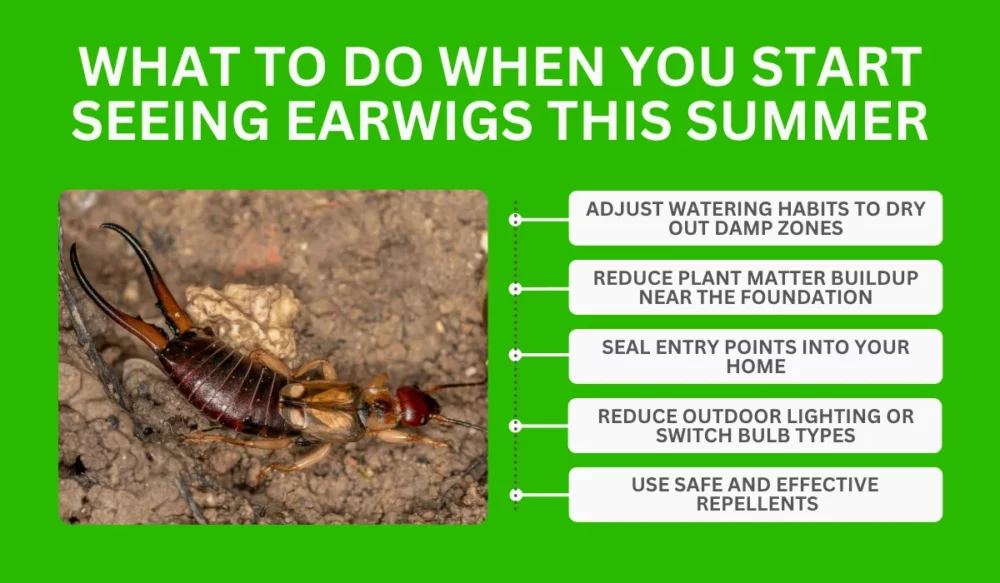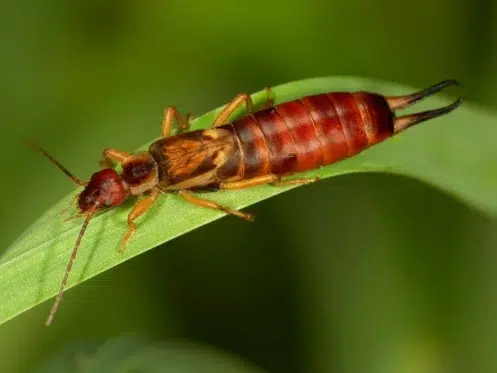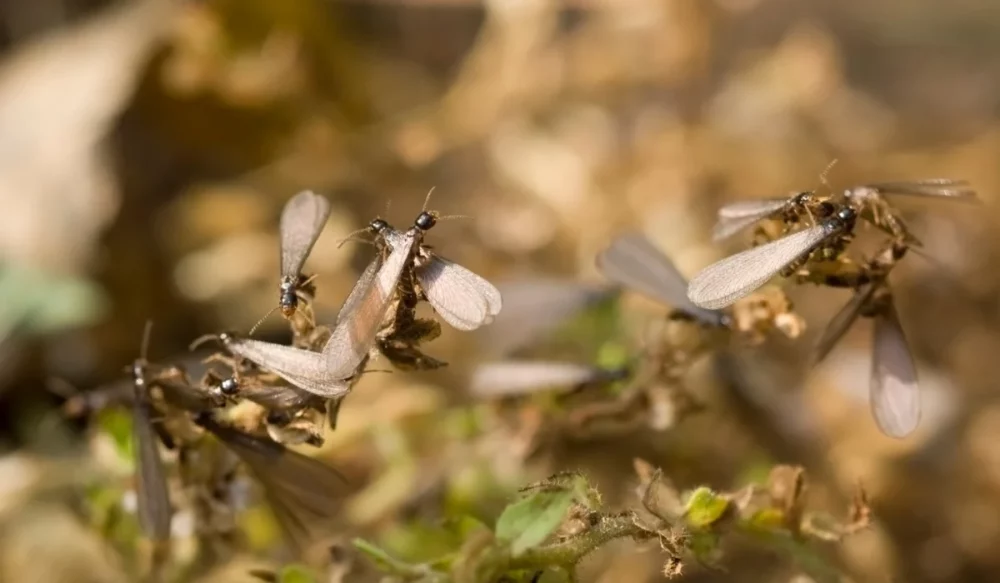You step outside one evening and spot something scurrying across the patio, reddish-brown, with long antennae and curved pincers on its back end. It’s not a roach, but it’s still not welcome.
Earwigs, also known as pinchers bugs, are out in full force this time of year across Tucson, and if you’re seeing more of them than usual, you’re not the only one.
This article will explain why earwigs are more active around your property during summer, especially in Southern Arizona, and what steps you can take to prevent a full-blown infestation.
Key Takeaways
- Monsoon rains and nighttime watering leave damp spots where earwigs hide, grow into nymphs, and lay their eggs.
- Fewer predators and cool indoor places like basements make it easier for earwigs to spread during summer.
- Moist soil, mulch buildup, and bright lights give earwigs food and shelter right outside Tucson homes.
- Safe repellents and home fixes can help, but professional services work best to keep earwigs out of your home for good.
Monsoon Season Fuels Damp Hiding Spots
When summer monsoons hit, Tucson’s typically dry environment transforms.
The heavy rains leave behind damp areas in gardens, crevices, and under mulch, exactly where earwigs love to hide. They thrive in moist environments and are quick to settle in areas with softened soil and shaded plant material.
These conditions also help nymphs grow quickly and allow females to lay eggs in protected, moist spots.
Irrigation Keeps the Soil Moist at Night
Drip systems and evening watering schedules keep the soil around your plants moist well into the night, especially during the hottest stretches of summer. This moisture makes your yard even more appealing to earwigs.
If your Phoenix or Tucson yard has thick mulch beds or soil that rarely dries out, you’re offering prime real estate to these reddish-brown invaders.
Landscape Materials Encourage Hidden Infestations
Many Arizona homeowners use rock, mulch, or wood chips to keep their yards low-maintenance and water-smart. While great for desert landscaping, these materials also hold onto moisture and create shaded gaps.
Earwigs wedge themselves between mulch layers, under decorative stones, and beneath planter boxes. Their flattened bodies and flexible cerci (those rear pincers) allow them to maneuver through the tightest crevices with ease.
Their Predators Disappear During Extreme Heat
Natural predators like birds, lizards, and frogs tend to disappear during the hottest parts of the day. With fewer threats, earwigs can multiply quickly and go about their scavenging with little interruption.
Without predator control, these insects can go from a minor nuisance to a widespread infestation before you even realize it.
Your Cool Indoor Spaces Offer Refuge
Basements, bathrooms, laundry rooms, and shaded garages can all become refuges for earwigs seeking escape from the desert heat.
Tucson homes with older window frames or poor door seals are especially vulnerable. Once inside, earwigs may gather in damp, dark places and scavenge for food sources like crumbs or decaying plant matter.
While they aren’t dangerous, their presence indoors can feel like a sign of bigger pest problems to come.
What to Do When You Start Seeing Earwigs This Summer

When earwigs start showing up around your property, it’s usually a sign that something in your environment is working in their favor.
The good news is, you can make a big difference with a few practical adjustments, such as:
Adjust Watering Habits to Dry Out Damp Zones
If you’re watering in the evening or running your irrigation too long, you’re giving earwigs a nightly drink and an ideal nesting site. Switch to early morning watering so the soil has time to dry out during the day.
Dry mulch and exposed soil make your yard less welcoming to pests that rely on humidity, like earwigs, termites, and roaches.
Reduce Plant Matter Buildup Near the Foundation
Earwigs feed on organic debris, including dead leaves, rotting wood, and even aphids.
To cut off their food supply, regularly rake your yard and trim back dense vegetation. Check for piles of decaying plant material near your home’s base or in garden beds, as these provide both cover and a buffet for earwigs and other pests.
Seal Entry Points Into Your Home
Use caulk or weatherstripping to close off cracks around doors, windows, and vents. Check the garage, basement walls, and laundry room for gaps.
While earwigs won’t tunnel like termites or sting like scorpions, their ability to slip into tight spaces means prevention is your first line of defense.
Reduce Outdoor Lighting or Switch Bulb Types
Earwigs aren’t attracted to lights the same way moths are. But the bugs that are drawn in, like moths, flies, and beetles, become easy meals.
If your porch light is pulling in insects, earwigs won’t be far behind.
The type of bulb you use makes a difference.
In a study led by ecologist Michael Justice, warm-colored LED bulbs attracted significantly fewer insects compared to traditional incandescent lights. If you’re using older bulbs, you may be unknowingly feeding the local pest population.
To make your outdoor space less inviting, try switching to warm-toned LEDs and limiting lighting when it’s not needed.
Less insect activity means fewer earwigs hanging around your entryway at night.
Use Safe and Effective Repellents
Plant-based repellents can help discourage earwigs without disrupting your landscape. Look for products specifically designed to control them or ask a local pest control provider for a non-toxic option that works well in the Arizona climate.
Avoid overusing harsh treatments.
Some repellents may impact beneficial insects or disrupt your garden’s balance.
Stop Earwigs Before They Take Over
If you’ve tried to get rid of earwigs and they keep coming back, it’s time to look beyond DIY solutions. Professionals can identify the root cause and eliminate the problem at its source.
At Green Home Pest Control, our Tucson exterminators specialize in eco-friendly earwig control that fits Arizona homes and lifestyles. We know how to treat crevices, inspect mulch zones, and target areas where earwigs like to hide, breed, and lay eggs.
Our pest control services are designed to be as effective as they are safe for your family, your pets, and your property. You shouldn’t have to tiptoe through your yard worrying about these pests or find one hanging out in your laundry basket.
Call us now to schedule a consultation or learn more about how we can help you control earwigs before they become a bigger issue.




